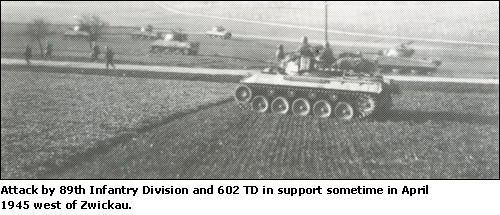The Mosel and Nahe River Crossings

On March 21st Company C took 389 more prisoners and Companies A and B took six more towns and 133 prisoners, including 7 officers. The Battalion Headquarters and the Headquarters Company were on the constant move to keep up with the progress eastward. In these actions, units of Recon Company were attached to the other companies and were a part of their actions. The days of March 22 to 25 were devoted mainly to preparing for the Rhine River crossing.
On 22 March, the 1st Platoon Recon Company reported seeing many U. S. Navy boats along the road headed toward the Rhine River. By 24 March, the Battalion Command Post had located in Beltheim several kilometers west of Oberwessel on the Rhine River. Other companies were scattered around the vicinity in places with names like Spesenroth, Klosterkumbd, Bickenbach, and Dudenroth. On 25 March Company A was attached to Task Force Ingell, and Companies B and C were attached to Task Force Johnson for exploiting a bridgehead across the Rhine River the next day. The 602nd TD men and M-18s were just far enough west of the river that they could not be seen from the eastern riverbank and the OPs located there. On the 24th and 25th units of Recon. Company reconnoitered the bridgehead area of Oberwesel and Bacharach. The only bridge across the Rhine River that had not been destroyed either by bombing or by the retreating German Army was at Remagen only a short distance north of Koblenz, to our north. The plan for crossing the Rhine was to use Navy boats for the first wave of attacks and also a temporary pontoon bridge thrown across by the 87th Infantry Division engineer's at the most narrow river point at Boppard. The plan also called for laying down a smoke screen over the river as protection from the machine guns and artillery of all sizes scattered along the steep and high rising bank. The attack was to begin at 2 a.m. on the 26th.
The 602nd Bn was still attached to the 89th Infantry Division. As the time for the attack neared, units of the 602nd moved with units of the 89th Infantry Regiments up near the top of the west bank of the river and stayed there while Infantrymen and equipment poured into the area below near the water and where the boats were waiting and being launched. For example, Company A had one or more of its platoons on the west bank just back of Oberwesel. After daybreak and at an early hour, the Company A Recon Section Sgt. Was sent by A Company Commander to join, as liaison, a meeting of 89th CP located in the basement of a building on the north side of Oberwesel. After day break and at an early hour the Company A Recon Section Sgt was sent by the A Company Commander to join, as liaison, a meeting at the 89th Division CP located in the basement of a building on the north side of Oberwesel. The Recon Sgt was the writer of this section and the jeep driver was Paul Portnowitz who went down the bank in a jeep and headed for the town a few hundred yards south. '"We stopped alongside a small structure as a volley of artillery was heard coming and landed between us and the building where the meeting was being held. Then we darted for the entrance where I dismounted quickly, and Paul pulled around behind the west bank side of the building as another volley hit the ground behind.
On entering the CP in the basement of the building, a report was heard assessing the progress of the attack. I then learned that initially the attack had been delayed a bit because unforeseen wind and/or temperature conditions had caused the smoke to hang to the riverbanks. Once that problem had been fixed the best way anyone knew, the boats had started to cross when the smoke opened up out in the middle and the east bank guns had taken a toll of men and boats, but some made it over to the east bank along the water. The conversation turned almost at once to the volleys of artillery landing on the town and west bank river front. Discussion had turned to options such as calling for help from the air. At that point, I rose and addressed the Brig. General, told him what unit I represented, that our guns were just up over the hill, and that we could stop the shelling by knocking the OPs out of the church steeples and castle tops. He scoffed at me, and as I was about to reassert my claim a Colonel rose and came to my defense saying why not give them a chance; I'll bet they can do it. As I moved quickly toward the door, I heard a mutter something about a court martial if this didn't work, but I went out along side the building until I found Paul and the jeep, radioed the A Co. CP,
and as the first 76mm shells went flying across the river, I returned to the meeting. I was asked if I had made contact and how soon this would happen; whereupon I indicated it was happening at that very moment. The meeting lasted another 15 minutes. When I came up out of the basement no artillery was falling on the town or river front."
|

